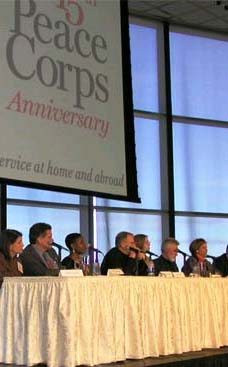2006.02.25: February 25, 2006: Headlines: COS - Zambia: Biology: Science: Wildlife: Bats: The Herald: Heidi Richter, a bat biologist from the University of Florida, first saw the nightly migrations when she was a Peace Corps volunteer in Zambia
Peace Corps Online:
Directory:
Zambia:
Peace Corps Zambia :
The Peace Corps in Zambia:
2006.02.25: February 25, 2006: Headlines: COS - Zambia: Biology: Science: Wildlife: Bats: The Herald: Heidi Richter, a bat biologist from the University of Florida, first saw the nightly migrations when she was a Peace Corps volunteer in Zambia
Heidi Richter, a bat biologist from the University of Florida, first saw the nightly migrations when she was a Peace Corps volunteer in Zambia
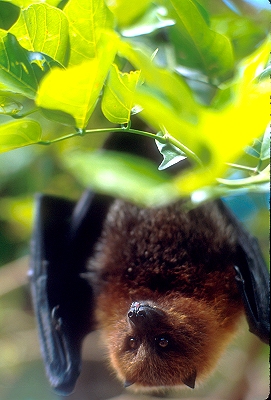
Heidi Richter, a bat biologist from the University of Florida, first saw the nightly migrations when she was a Peace Corps volunteer in nearby Serenje. She returned to the area to complete a masters degree and then again to research her PhD, tracking the bats by satellite during the ten months of the year they are away from the park. She discovered that many of the female bats at Kasanka are pregnant, which suggests they may visit to find specific nutrients in the forest.
Heidi Richter, a bat biologist from the University of Florida, first saw the nightly migrations when she was a Peace Corps volunteer in Zambia
Eight million little mysteries Every year an inconceivable colony of fruit bats descends on a forest in Zambia. but why? Award-winning Herald photographer Kieran Dodds has the answer in his sights.
Feb 25, 2006 - The Herald
In the darkness I can barely see my legs below me, never mind any black mambas or crocodiles. Changwe - my Zambian guide, and a bat- catcher extraordinaire - asks me to keep my headlamp switched off. My feet crunch into a deep leaf litter with every blind step, and occasionally I stumble over fallen logs or scratch my head on branches.
Outside the forest, under the moonless sky, a dew is forming on the dry grass as sunrise approaches. The rains have been late again this year, but in Kasanka National Park the fruit is flourishing in abundance and attracting one of Africa's greatest and least observed wildlife spectacles: the arrival of the bats.
For ten months of the year you can walk this path during the day and see antelopes, pythons and elephants cross your path. But in November and December around eight million strawcoloured fruit bats throng the skeletal trees in this overlooked corner of Zambia, next to the Democratic Republic of Congo.
At 4am, against a starry sky, the Kasanka bats begin to return from their nightly forage and start to hang in their millions from the trees of the mushitu swamp forest. A sweet smell drifts down from the canopy generated by their wings: a pleasant surprise if you've ever experienced the stench of the guano-covered caves so many of their brethren inhabit.
At a mere 217 square miles, Kasanka has the greatest recorded concentration of mammal life on the planet. There is 2,500 tonnes of bat life here tonight - the equivalent of around 500 elephants - hanging across an area of forest measuring the equivalent of ten football pitches. Walking under a tree holding even one elephant would be unwise, but Changwe, leaping over the broken branches ahead of me, reassures me that he has never been hit by a falling bat. (Or elephant. ) At around 5.30am the sun races into the African sky, illuminating the bats' intricate wings, and the blood vessels that supply their muscles and membranes.
Squadrons of the creatures, each of which has a wingspan measuring up to a metre, are still returning from foraging, and spiralling around the trees.
Their method of landing, it has to be said, could be more graceful. Attaching their clawed feet to tree branches, the bats fall headlong into a bundle of leathery wings. A passing fish eagle, spotted by hundreds of attentive eyes in the cluster, causes a flurry of activity which abates only after the culprit is chased away.
Straw-coloured fruit bats are a migratory species living in large, conspicuous colonies on the edges of forests, towns and cities, with a range covering the tropical belt of Africa.
Historic colonies exist in Sudan, moving south into Zambia and through Uganda, Tanzania, western Kenya and the Democratic Republic of Congo; each contains at least hundreds of thousands, if not millions, of bats. The species even reaches the menu of certain hotels further west in Nigeria and Ivory Coast, although at Kasanka the chefs at the main lodge refuse to cook them.
The Kasanka bats are of special interest because of the vast size of the colony and the mystery that surrounds their movements.
Every night during their two-month roost the bats pour out across the sky, shading it in every direction across a radius of 40 miles or more.
By the end of December, however, the bats have moved on. Until recently, nobody knew where to - but new satellite tracking research is revealing their flight to the Democratic Republic of Congo.
Heidi Richter, a bat biologist from the University of Florida, first saw the nightly migrations when she was a Peace Corps volunteer in nearby Serenje. She returned to the area to complete a masters degree and then again to research her PhD, tracking the bats by satellite during the ten months of the year they are away from the park. She discovered that many of the female bats at Kasanka are pregnant, which suggests they may visit to find specific nutrients in the forest.
Richter describes a "big bang" of fruit production in the park during November, which acts like a magnet to the bats. The simultaneous fruiting of wild loquat, red milkwood and water berry enables millions of bats to feed, consuming up to twice their body weight - they eat an estimated 5,000 tonnes of fruit every night. And that's just the straw-coloured bats: there are seven other species of fruit bat in the park.
It is no surprise to locals that the bats come in such numbers. Human beings used to do the same thing. Kasanka means "place where people come to harvest" and for generations people visited the region for its meat, fish and fruit. But in 1945 families were removed from the area in order for a game reserve be set up.
Although it was granted national park status in 1972, the area was given little protection from poachers, and was in effect plundered of its wildlife over the decades.
By the mid-1980s, it was thought to be empty: when David Lloyd, a British expat living in Zambia, asked the government for permission to investigate the park's tourism potential, he was told there was no wildlife left. But to his delight, while he was surveying the area, Lloyd heard the sound of gunshots.
If poachers were still active, he surmised, there must be wild animals left. He installed anti-poaching patrols in the park and won the support of the legal system in fining poachers;
then he introduced zebra and buffalo to the area. Slowly the wildlife populations began flourishing again. And the bats are flourishing more than most.
Their intense activity in Kasanka takes its toll on the forest, stripping the trees bare and eventually killing them. Yet protecting the bats in the long term is vital. Fruit bats are essential for the regeneration of Africa's tropical forests: they are responsible for at least 60 per cent of tropical rainforest seed dispersal, including those used for timber and cash crops. In west Africa, a study has shown that some 300 million seeds of iroko, a valuable hardwood, were spread by the bats over hundreds of square miles in just one night.
Cashew, mango and figs are also among the 300 species that rely on bats. The economic and environmental impact of these fascinating creatures is only now becoming clear.
When this story was posted in April 2006, this was on the front page of PCOL:





Peace Corps Online The Independent News Forum serving Returned Peace Corps Volunteers
 | The Peace Corps Library
The Peace Corps Library is now available online with over 40,000 index entries in 500 categories. Looking for a Returned Volunteer? Check our RPCV Directory. New: Sign up to receive PCOL Magazine, our free Monthly Magazine by email. Like to keep up with Peace Corps news as it happens? Sign up to recieve a daily summary of Peace Corps stories from around the world. |
 | PCOL readership increases 100%
Monthly readership on "Peace Corps Online" has increased in the past twelve months to 350,000 visitors - over eleven thousand every day - a 100% increase since this time last year. Thanks again, RPCVs and Friends of the Peace Corps, for making PCOL your source of information for the Peace Corps community. And thanks for supporting the Peace Corps Library and History of the Peace Corps. Stay tuned, the best is yet to come. |
 | History of the Peace Corps
PCOL is proud to announce that Phase One of the "History of the Peace Corps" is now available online. This installment includes over 5,000 pages of primary source documents from the archives of the Peace Corps including every issue of "Peace Corps News," "Peace Corps Times," "Peace Corps Volunteer," "Action Update," and every annual report of the Peace Corps to Congress since 1961. "Ask Not" is an ongoing project. Read how you can help. |
 | PC announces new program in Cambodia
Director Vasquez and Cambodia's Deputy Chief of Mission Meng Eang Nay announced a historic new partnership between the Peace Corps and the Kingdom of Cambodia that will bring volunteers to this Southeast Asian country for the first time. Under King Norodom Sihamoni and Prime Minister Hun Sen, Cambodia has welcomed new partnerships with the U.S. government and other U.S. organizations. |
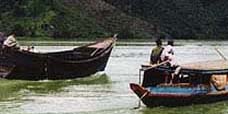 | Peace Corps suspends program in Bangladesh
Peace Corps Director Gaddi H. Vasquez announced the suspension of the Peace Corps program in Bangladesh on March 15. The safety and security of volunteers is the number one priority of the Peace Corps. Therefore, all Peace Corps volunteers serving in Bangladesh have safely left the country. More than 280 Peace Corps volunteers have served in Bangladesh since the program opened in November 1998. Latest: What other newspapers say. |
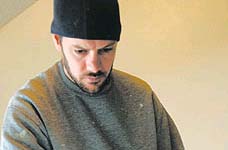 | Invitee re-assigned after inflammatory remarks
The Peace Corps has pulled the invitation to Derek Volkart to join the Morocco Training Program and offered him a position in the Pacific instead after officials read an article in which he stated that his decision to join the Peace Corps was in "response to our current fascist government." RPCV Lew Nash says that "If Derek Volkart spoke his mind as freely in Morocco about the Moroccan monarchy it could cause major problems for himself and other Peace Corps volunteers." Latest: Volkart reverses stance, takes new assignment in Paraguay. |
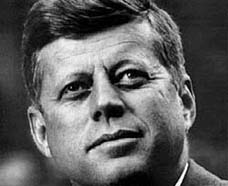 | March 1, 1961: Keeping Kennedy's Promise
On March 1, 1961, President John F. Kennedy issues Executive Order #10924, establishing the Peace Corps as a new agency: "Life in the Peace Corps will not be easy. There will be no salary and allowances will be at a level sufficient only to maintain health and meet basic needs. Men and women will be expected to work and live alongside the nationals of the country in which they are stationed--doing the same work, eating the same food, talking the same language. But if the life will not be easy, it will be rich and satisfying. For every young American who participates in the Peace Corps--who works in a foreign land--will know that he or she is sharing in the great common task of bringing to man that decent way of life which is the foundation of freedom and a condition of peace. " |
 | Paid Vacations in the Third World?
Retired diplomat Peter Rice has written a letter to the Wall Street Journal stating that Peace Corps "is really just a U.S. government program for paid vacations in the Third World." Director Vasquez has responded that "the small stipend volunteers receive during their two years of service is more than returned in the understanding fostered in communities throughout the world and here at home." What do RPCVs think? |
 | RPCV admits to abuse while in Peace Corps
Timothy Ronald Obert has pleaded guilty to sexually abusing a minor in Costa Rica while serving there as a Peace Corps volunteer. "The Peace Corps has a zero tolerance policy for misconduct that violates the law or standards of conduct established by the Peace Corps," said Peace Corps Director Gaddi H. Vasquez. Could inadequate screening have been partly to blame? Mr. Obert's resume, which he had submitted to the Peace Corps in support of his application to become a Peace Corps Volunteer, showed that he had repeatedly sought and obtained positions working with underprivileged children. Read what RPCVs have to say about this case. |
 | Why blurring the lines puts PCVs in danger
When the National Call to Service legislation was amended to include Peace Corps in December of 2002, this country had not yet invaded Iraq and was not in prolonged military engagement in the Middle East, as it is now. Read the story of how one volunteer spent three years in captivity from 1976 to 1980 as the hostage of a insurrection group in Colombia in Joanne Marie Roll's op-ed on why this legislation may put soldier/PCVs in the same kind of danger. Latest: Read the ongoing dialog on the subject. |
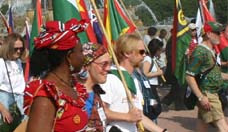 | Friends of the Peace Corps 170,000 strong
170,000 is a very special number for the RPCV community - it's the number of Volunteers who have served in the Peace Corps since 1961. It's also a number that is very special to us because March is the first month since our founding in January, 2001 that our readership has exceeded 170,000. And while we know that not everyone who comes to this site is an RPCV, they are all "Friends of the Peace Corps." Thanks everybody for making PCOL your source of news for the Returned Volunteer community. |
Read the stories and leave your comments.

Some postings on Peace Corps Online are provided to the individual members of this group without permission of the copyright owner for the non-profit purposes of criticism, comment, education, scholarship, and research under the "Fair Use" provisions of U.S. Government copyright laws and they may not be distributed further without permission of the copyright owner. Peace Corps Online does not vouch for the accuracy of the content of the postings, which is the sole responsibility of the copyright holder.
Story Source: The Herald
This story has been posted in the following forums: : Headlines; COS - Zambia; Biology; Science; Wildlife; Bats
PCOL32391
74










